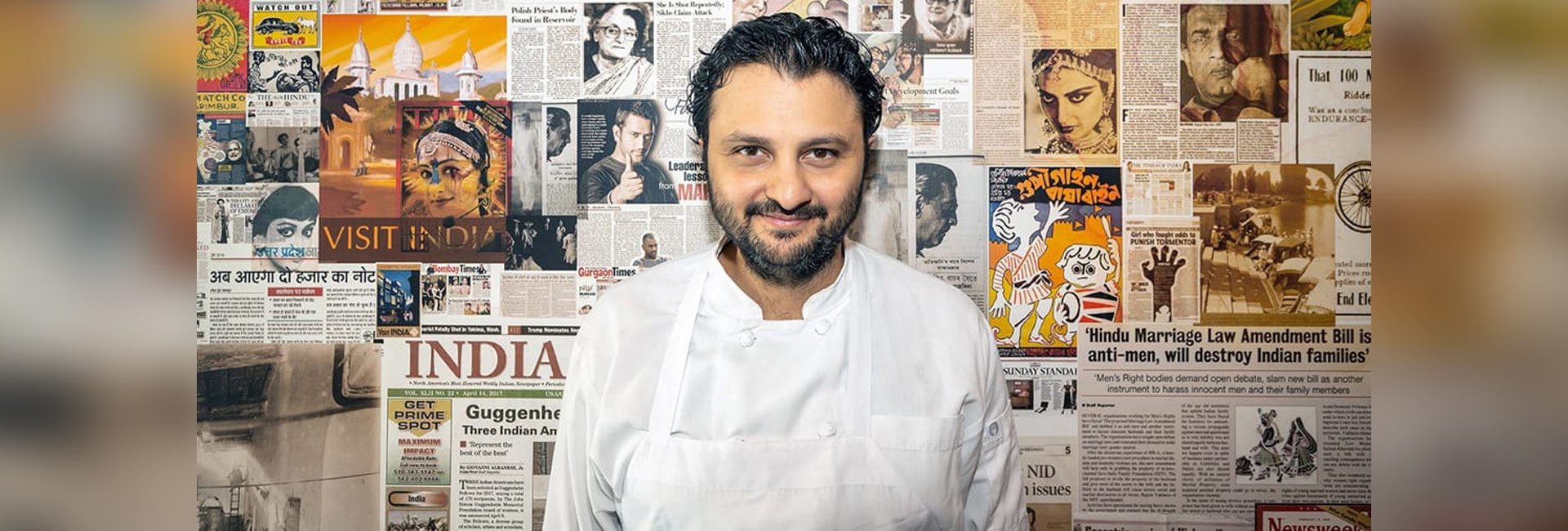(January 6, 2023) When Vineet Bhatia first moved to England in 1993 as the Executive Chef at Star of India, South Kensington, he had no idea about what a Michelin star was. Exactly three decades later, the chef who is also a restaurateur and an author, has been awarded the Most Excellent Order of the British Empire (MBE), making him the first Michelin-starred chef of Indian origin to be bestowed with the honour by the monarch of the United Kingdom, King Charles III. The chef took to social media to make this announcement, and wrote, “Honoured to be the first Michelin-starred chef of Indian origin to be awarded an MBE. (It’s) a wonderful privilege to have the opportunity to make the world ‘see things differently’ about the United Kingdom.” He dedicated this honour to his mother and wife.

Chef Vineet Bhatia
Chef Bhatia, who is also the first Indian chef to be awarded a Michelin star for his restaurant Zaika in London, is the only Indian in the culinary world to receive two Michelin stars. “The Michelin team goes to restaurants discreetly. So, one doesn’t know that they are serving a jury,” shares the eminent chef. “I was thrilled when I received the news that I had won the Michelin star, but more so for creating history, as it was nothing less than opening the door for all the Indian chefs and Indian cuisine across the globe. Today, it makes me very proud when I see other Indian chefs winning the star.”
A living bridge between India and the United Kingdom, the celebrity chef discusses much more than just his culinary journey as he connects with Global Indian from London.
Not a born chef
Born and raised in the city of dreams, Mumbai, Vineet, too, grew up with a dream of his own – to become a pilot. “I lived quite close to an aerodrome, and so I used to watch planes flying in and out every day. Being a pilot was the only plan I had as a kid,” says the celebrity chef, who also cracked the National Defence Exam to join the Air Force. “But I wasn’t tall enough,” he shares, adding, “They told me that I could join the Indian Army or Navy, but I wasn’t interested.”

Disheartened, but not defeated, Chef Bhatia turned towards the culinary world. But not before giving bartending a shot. “I wanted to become a bartender. But again, I wasn’t tall enough,” he laughs. However, his experience in the kitchen was life-changing. “As a 17-year-old, I was fascinated with how the kitchen was run so immaculately and that everyone involved was disciplined.”

Chef Bhatia bringing Tacos to Indian Cuisine
After completing his training at the Oberoi School of Hotel Management, New Delhi, Chef Bhatia worked as the Chef de Cuisine or head chef at The Oberoi in Mumbai for the next three years. However, it was an uphill task initially. “In the kitchen, you have to earn the respect of your staff. When I first joined, one of my staff members told me, ‘I have more pending leaves than your whole experience.’ So, I worked hard to earn their respect. I told them that I wasn’t there to teach them how to cook, but to help them with whatever they needed to put out a great dish,” shares the chef, whose comfort food is a simple meal of tadka dal, chawal, and achar. “As soon as I land in Mumbai, I go to the pani puri stall and have a nice plate of golgappa and chaat. And later, some cutting chai,” share the chef with a smile.
A decade after moving to the UK, the chef and his wife Rashima Bhatia, opened their first restaurant, Rasoi in Chelsea in 2004, which earned him his second Michelin star in 2006. Since then, he has opened 11 restaurants across the globe including Moscow, Los Angeles, Dubai, Mumbai, Doha, and Jeddah.
Behind the scenes
While the dishes that come out of the kitchen look beautiful, the kitchen itself is a bit chaotic. “Kitchen is not easy. There are so many things happening at the same time,” the seasoned chef says. “The front of a restaurant seems so calm and controlled – which is the way it is supposed to be – but the kitchen is where all the action is going on. Everyone in the kitchen is running around to put that dish on the table. So, your movements have to be very coordinated. There is food in the oven, overhead grill, tandoor, and pan. There is a dessert going out and the plates are falling short… Something is happening in the kitchen at all times. It is a mechanism that works in tandem.”

Chef Bhatia’s pistachio chicken seekh kabab
Having opened so many restaurants, the chef calls it a long and tedious process. Apart from deciding the food and beverages that will feature on the menu, the restaurateur also has to work on its theme, colour palette, style, and overall ambiance. “We have to sit with the designers of course, and can take very long to decide all the factors, before the execution. The staff, again, has to be very well-trained, because otherwise, everything will collapse. So, we take time in training all of them.”
Man of many talents
A world-renowned chef, author, TV personality, and social activist – Chef Bhatia dons many hats. But not many know that “travel” has his heart. “My work takes me to places, but I enjoy travelling a lot,” shares the chef, who was very recently on a trip to the Arctic, an experience he calls “magical.”

Chef Bhatia with his family
Interestingly, Chef Bhatia is the only chef in the world to cook at the base camp of Mount Everest in 2018. Calling the experience “stunning”, the chef shares, “We were raising funds for a charity called Heart For India in Chennai, which looks after 3000 kids, and also for the victims of the 2015 Himalayan earthquake. So, my team and I trekked for 15 days to get to the base camp of Mt Everest and set up a restaurant for two days. We gave the mountaineers and trekkers free food, and whatever they wanted to donate went toward these two causes. It was one of the most incredible experiences of my life.”

Vineet Bhatia believes in working with local ingredients with nuanced Indian techniques
An active campaigner for sustainability in the culinary world, Chef Bhatia was also recently appointed as the GREAT ambassador to the United Kingdom. “I think it is important that while we want to have the products from the international market, we have to ensure that they are ethically sourced. It is not just about using paper over plastic, but also about how the farming is done or how the meat is sourced,” explains the chef, before he signs off.
Also Read: A royal feast: Yuvrani Shraddha Bhonsle’s modern touch to Sawantwadi’s culinary heritage




